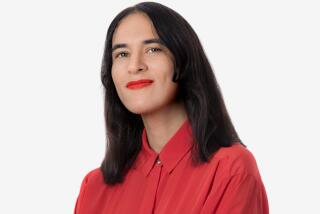Tina Brown Unexpectedly Resigns as New Yorker Editor
- Share via
NEW YORK — Tina Brown, one of the nation’s most closely watched magazine editors, stunned the publishing world Wednesday by unexpectedly resigning after six years as editor of the New Yorker magazine.
The move raised fresh questions about the future of the venerable but money-losing magazine, a landmark on the American literary scene that has been the launching pad for such notable works as John Hersey’s “Hiroshima” and showcase for such respected authors as John Updike, Truman Capote and James Baldwin.
Brown will head a new-media venture with Miramax Films, the maverick independent movie distributor owned by Walt Disney. The venture will begin with publication of a monthly, unnamed magazine, and Brown will appear on some television specials.
Brown’s departure comes amid a turbulent time for the magazine known for its independence, lengthy literary pieces and humorous cartoons. Brown is understood to have been apprehensive about recent changes at the New Yorker as it was forced to move deeper under the corporate umbrella of parent Conde Nast Publications.
An effort is underway to combine the New Yorker’s operations with those of Conde Nast’s other magazines, including Vogue and Vanity Fair. At the start of the Memorial Day weekend, a Conde Nast executive removed his own brother as president of the New Yorker, which lost $11 million last year and has a circulation of 800,000.
Brown also viewed the magazine as a base for other projects, including movies, television and books--a view that was not greeted with enthusiasm by some at Conde Nast.
*
Brown conferred with billionaire S.I. Newhouse Jr., chairman of Advance Publications, the parent company of Conde Nast, and turned down a new five-year contract.
“He was surprised. He was sad. We both were,” she said in an interview.
Then, after meeting privately in her office with six key editors and writers, she assembled the entire staff in the main hallway on the 17th floor of the New Yorker’s midtown offices.
“She told them she had accepted the offer to chair the division at Miramax,” said Henry Finder, the New Yorker’s editorial director. “There were stricken looks and tears from everyone from typesetters to fact checkers.”
Brown’s appointment in 1992 as editor, after she was credited with turning around Vanity Fair magazine, was a bombshell in New York’s publishing world. Brown’s emphasis on celebrities and glitz was considered sacrilegious--at Vanity Fair she put a picture of a nude, pregnant Demi Moore on the cover and at the New Yorker published numerous articles about the O.J. Simpson case. Brown hired Roseanne to be a consulting editor of one New Yorker issue, prompting two writers to quit in protest. Those actions reinforced views of critics who felt she was not qualified to occupy the editor’s chair once held by the legendary and highly dignified William Shawn.
But Brown also had strong supporters. She quickened the pace of the magazine, made it more topical, adding photographs and increasing coverage of politics, the media and pop culture. Articles were shortened. An effort was made to move the New Yorker deeper into the mainstream of discussion and debate.
At the same time, she increased the magazine’s coverage of science, economics, business and medicine.
“She thought ideas could be sexy,” said one of the magazine’s editors. “Her legacy is intricate, it is misunderstood. . . . She was a much more complex and comprehensive editor than people gave her credit for. You would get faxed all hours of the night about pieces.”
“There is no one like her for spotting flaws and brilliance in pieces and bringing out the best in writers,” said Dorothy Wickenden, the New Yorker’s executive editor. “She took what had been the world’s greatest magazine, which had become deadly moribund, and reinvented it in many ways.”
“Tina Brown is one of the smartest idea people anywhere,” said DreamWorks SKG partner Jeffrey Katzenberg. “She has an unbelievable instinctive nose for the big idea.”
Brown’s departure leaves the magazine searching for a strong new central voice. From the day she became editor, it was very much her magazine.
“She personifies the New Yorker,” said Steven Cohn, editor of Media Industry Newsletter, who predicted her departure would leave a huge gap. “Some people buy the New Yorker because of Tina Brown.”
The Oxford-educated native of Britain was the epitome of the celebrity editor, writing in the first person about having lunch with Princess Diana, attending a state dinner at the White House with President Clinton as well as throwing parties attended by top Hollywood stars. She could move effortlessly between the street and the literary salons.
Brown and her husband, former Random House chief Harry Evans, are one of New York’s most visible power couples, with their lives regularly chronicled in the city’s gossip columns. Evans now is vice chairman and editorial director of the Daily News.
*
In an interview, Brown and Miramax co-Chairman Harvey Weinstein described the venture.
“The first project out of the box will be a monthly national magazine, upscale, provocative, contemporary . . . from which a lot of other things can be grown,” Brown said.
Brown will serve as chairman, and Ron Galotti, the publisher of Vogue, who also also resigned to join the new venture, will be president of the Miramax division. Both will receive an equity stake in the venture--an important consideration in her decision to leave the New Yorker.
“It is a perfect fit, the kind of journalism I practice and the kind of movies Harvey does,” Brown said.
The mood at the New Yorker was shock mixed with worry as the search for a new editor began.
Some staff members speculated the magazine could appear twice a month in an effort to save money, though a source said after that idea was investigated the conclusion was reached it would not be prudent.
“It has been an extraordinary six years. This makes us very apprehensive about what’s next,” said senior editor Hedrik Hertzberg. “As far as I know, nobody saw it coming. . . . I think people are genuinely stunned.”
Brown said she and Newhouse did not discuss her successor, but they planned to meet again this week.
The New Yorker’s new editor should be someone “who champions good writing,” she said. “That is the most important thing about that job.”
*
Under her arrangement with Miramax, Brown not only will start a new magazine, she will participate in four television specials.
“[ABC chief] Bob Iger and Harvey have been talking to Tina on and off for a while, for several months about things she can do inside the company,” said Rob Moore, executive vice president for finance at Disney.
“I think she felt she accomplished everything she wanted to at the New Yorker and wanted a new challenge,” said Cohn. “Some of the discord at the New Yorker probably helped her decision.”
Although the New Yorker has won numerous awards under Brown, it continued to bleed red ink for Newhouse. In its latest issue, Fortune magazine estimates that Newhouse has lost money every year since buying the magazine in 1985 for $168 million, with total losses of $175 million in that time.
Brown will be joining a far different culture than the oft-contemplative atmosphere of the New Yorker, where tight editing and fact-checking prevail.
Miramax, run by Weinstein and his brother Bob, is scrappy and contentious, befitting financially savvy showmen. Both men have been known to scream on occasion--and when that happens people move. People who know Brown predict she will more than hold her own in her new milieu.
Brown said she and Galotti, who worked together when she was editor and he was publisher of Vanity Fair, will have editorial independence “to operate any way we wish.”
“The idea of a multimedia company where they run it was very exciting for them,” said Weinstein, who telephoned Newhouse on Wednesday.
“I spoke to Si, and he was incredibly gracious once he understood the ownership concept. Si is an owner himself.”
*
In the small meeting in her office before addressing the New Yorker’s staff, Brown said the recent death of her mother after a long struggle with cancer gave her “clarity” as she weighed Weinstein’s offer.
She said before speaking with the co-chairman of Miramax she had intended to remain at the New Yorker, but was not enthusiastic about signing a contract for five years, as Newhouse offered.
“Si Newhouse has been a Medici. He has tolerated losses at the New Yorker and subsidized it,” said one of the magazine’s star writers. “He allowed her to spend money on writers and staff. Will he continue to do that or will he make some change? He could pull the plug on the magazine. He could bring in a new editor.
“Tina expects him to bring in a new editor. She thinks with the sale of Random House [by Newhouse] the New Yorker is the jewel in his crown.”
Times special correspondents Diane Seo and Lisa Meyer in New York and Richard Natale in Los Angeles contributed to this report.
(BEGIN TEXT OF INFOBOX / INFOGRAPHIC)
Brown’s Impact
Circulation and advertising at the New Yorker grew after Tina Brown took over as editor in September 1992, then dropped in recent years. She is credited with making the magazine livelier.
Circulation (In hundred of thousands:)
Note: Figures are for the last six months of each year
****
Advertising
Number of ad pages annually:
1991: 2,003
1992: 2,007
1993: 2,253
1994: 2,100
1995: 2,128
1996: 2,032
Sources: Audit Bureau of Circulations, Media Industry Newsletter
researched by WILLIAM HOLMES / Los Angeles Times
More to Read
Sign up for our Book Club newsletter
Get the latest news, events and more from the Los Angeles Times Book Club, and help us get L.A. reading and talking.
You may occasionally receive promotional content from the Los Angeles Times.










